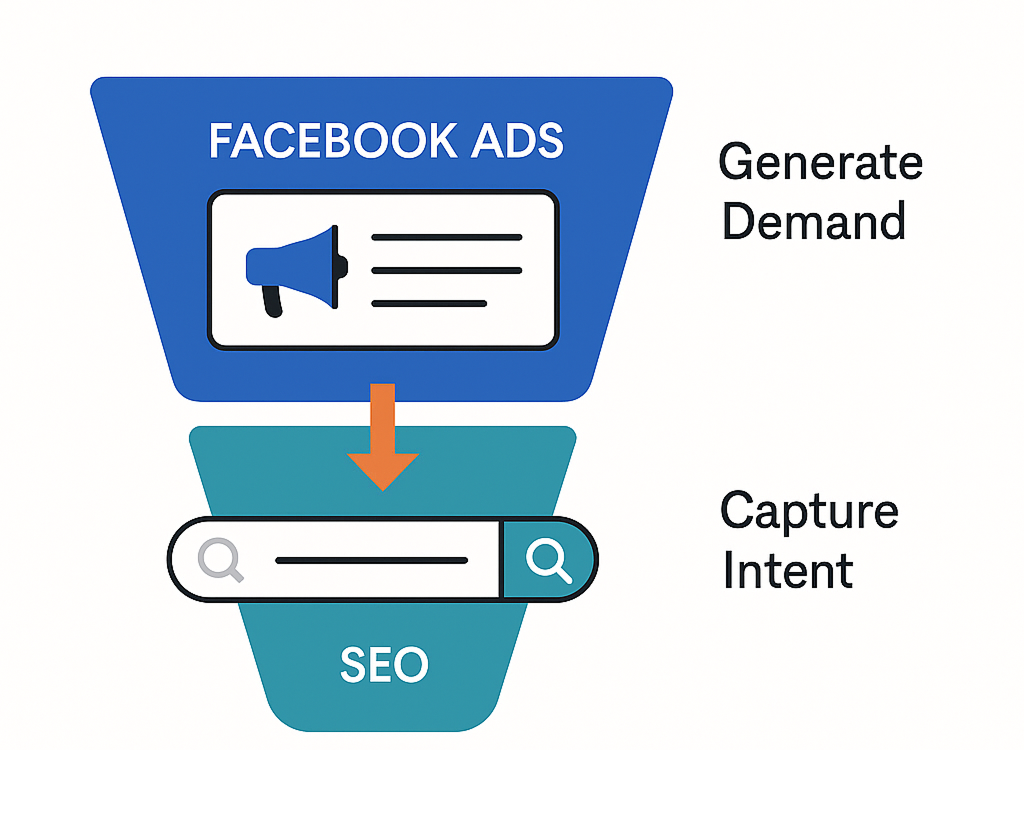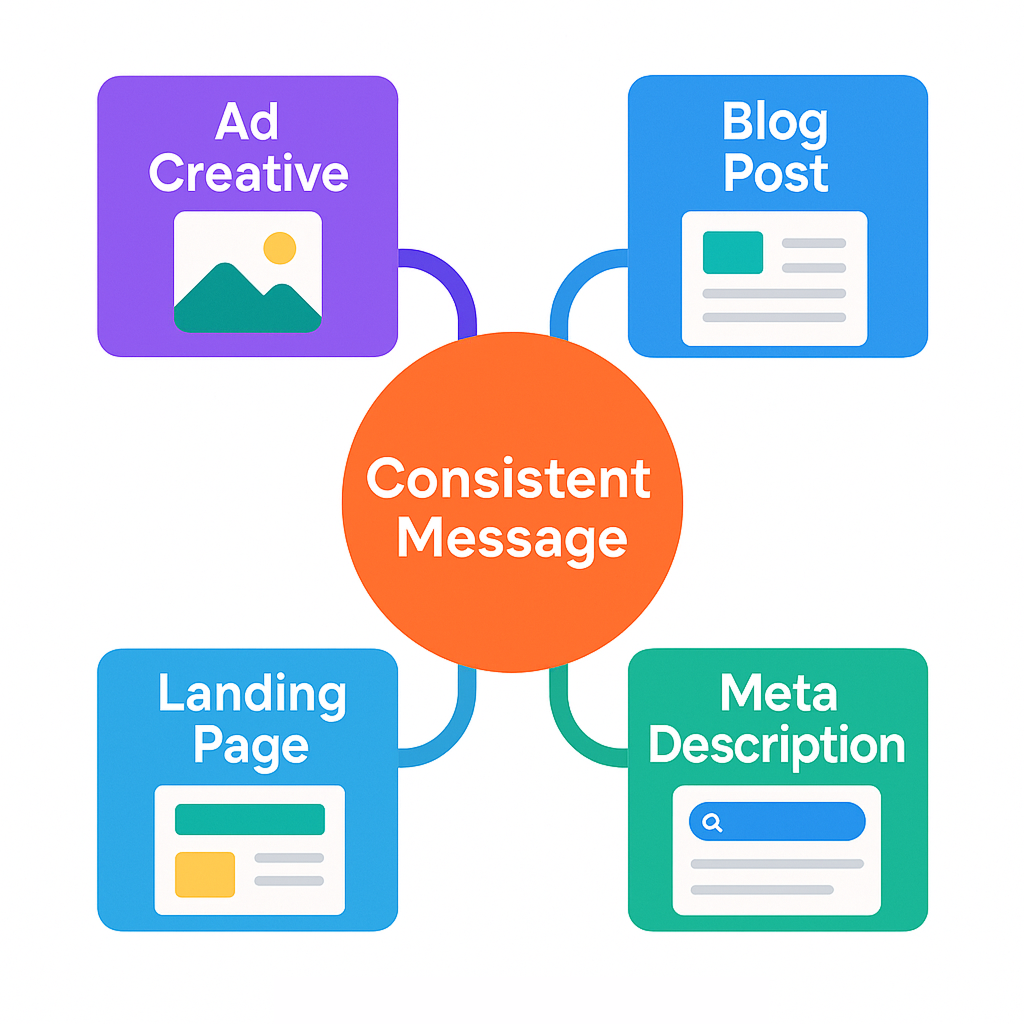Smart marketers don’t think in channels. They think in experiences.
If you’ve been running Facebook Ads and SEO campaigns in parallel — but not together — you might be missing out on some serious performance lift.
Combining Facebook ads with organic search strategies creates a powerful flywheel effect. One feeds the other. One builds the brand, the other captures the intent. Let’s break down exactly how they complement each other — and how to make the most of both.

1. More Touchpoints = Higher Conversion Potential
Most users won’t convert the first time they see your brand. They need to trust you first. That’s why combining awareness-focused Facebook campaigns with high-intent organic content is so effective.
Here’s how it plays out:
-
Facebook Ads spark discovery. You’re reaching users who didn’t know you existed, often through visual-first creatives. These impressions introduce your brand to cold audiences — making them aware of what you offer.
-
Organic search provides credibility. When those users search for you later — either by brand name or product keywords — a strong organic presence reinforces trust. Ranking high in search results signals legitimacy and authority.
-
Multiple touchpoints deepen trust. Seeing your brand across channels — in ads and in organic listings — creates a familiarity loop. It reduces hesitation, builds brand recall, and increases the likelihood of action during future sessions.
Want to maximize this effect? Make sure your brand ranks for your own name and product terms. If your ad viewers Google you and find nothing — or worse, competitors — you’re leaking conversions.
Pro tip: Learn how to optimize targeting for higher trust and relevance.
2. Paid Social Creates Demand — SEO Captures It
One of the biggest advantages of Facebook Ads is demand generation. You introduce users to products they didn’t even know they needed.
Then, curiosity kicks in.
People open Google and start searching: Is this legit? How does it work? What are the reviews?
If you have strong organic content that answers those questions, you're ready to convert that interest.
Try this strategy:
-
Use top-of-funnel Facebook ads to introduce your solution. Focus on value-driven, problem-solving messaging — not the hard sell. Educational videos and lifestyle images work well.
-
Monitor rising branded or product-related search terms in Google Search Console. Look for patterns in how users are discovering your brand after seeing your ads.
-
Create blog content and landing pages optimized for those queries. Answer common questions, compare alternatives, and showcase benefits. This builds trust and moves users closer to action.
This way, your organic search captures the intent generated by paid discovery.
3. Retargeting Works Better When You Add Search Traffic
Facebook’s retargeting power increases dramatically when your SEO content brings in qualified, organic traffic. Think of your blog, product pages, and comparison guides — they all attract users with intent.
When those users don’t convert right away, use Facebook retargeting ads to follow up. You already know they’re interested based on their search behavior.
Here’s how to do it:
-
Set up pixel tracking on all organic traffic landing pages. Don’t just track your product or checkout pages. Track blog posts, guides, and category pages to build wider audiences.
-
Create Custom Audiences based on behavior — such as time on site, scroll depth, or return visits. These signals indicate genuine interest, not accidental clicks.
-
Use dynamic creative to match your retargeting ads with the specific topics users explored. For example, if they read a guide on "email automation tools," show them an ad that highlights your tool’s automation features.
If you're not sure how to structure retargeting audiences, this guide to setting up Facebook retargeting walks you through it.
4. Messaging Synergy Across Channels
Most Facebook campaigns fail when the ad says one thing, and the landing page says something else.
When your SEO content reflects the same tone, pain points, and benefits as your Facebook ads, it creates a seamless experience.

Use performance insights from one channel to improve the other:
-
Take high-performing Facebook ad copy — headlines, value propositions, emotional triggers — and test it in blog posts, title tags, and meta descriptions. If it works in paid social, it might also increase click-throughs on Google.
-
Use popular blog topics to fuel new ad campaigns. If users are already searching for a topic or solution, consider amplifying that message via paid ads to drive more visibility and test conversions.
Want to explore angles that work well in paid campaigns? Try running quick creative tests with Facebook’s learning phase to identify messages that click with your audience.
5. Efficient Budget Scaling Without Guesswork
Facebook gives you fast data. Organic gives you long-term growth.
When you align the two, you can scale smarter:
-
Use ads to test new offers. Run A/B tests on lead magnets, product bundles, or calls to action. If something gets traction fast, that’s a signal to build organic content around it.
-
Build organic content around winning offers. This ensures lasting visibility, especially for mid- and bottom-of-funnel queries.
-
Reduce paid spend on keywords where you now rank organically. Why keep paying for clicks you already own? Shift that budget to testing new audiences or creatives.
This lets you keep CAC low and ROAS high — without endlessly increasing budgets.
And when things don’t perform as expected? Avoid wasting spend by understanding what happens when your ad set gets zero impressions.
6. Smarter Audience Insights From Search Behavior
Combining data from Facebook and organic search helps you understand your audience better.
For example:
-
Which search queries are leading to purchases? Use that data to build Facebook Custom Audiences based on user interest and search intent.
-
Which blog topics have high engagement but low conversion? These may be good candidates for retargeting sequences or lead magnet offers.
-
Which audiences are bouncing on Facebook but converting through Google? You might need to rework your creative or improve pre-click experiences for those segments.
This level of insight can dramatically improve your ad targeting. For more on defining high-intent segments, check out this step-by-step targeting guide.
Final Thought: Cross-Channel Doesn’t Mean Complicated
You don’t need a massive team or tech stack to make this work. You just need alignment.
-
Align your messaging. Keep the tone, benefits, and core hooks consistent across paid and organic.
-
Align your data. Look at how traffic behaves across sources and let that shape your campaign structure.
-
Align your strategy. Let each channel support the other — don’t make them compete.
Because your customers don’t care if they found you via a Facebook ad or a blog post — they care if you’re solving their problem.
When both channels work together, that solution becomes clear, credible, and easy to act on.

